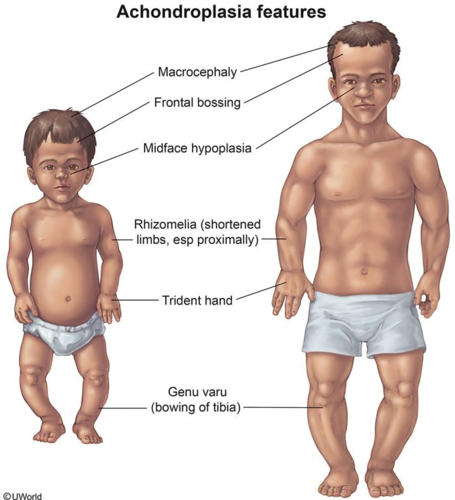Achondroplasia prevalence refers to the occurrence of this genetic condition in the global population. It is one of the most common forms of achondroplasia dwarfism, characterized by short stature due to abnormal bone development. Understanding the percentage of people affected by achondroplasia provides critical insights into how this genetic condition is distributed across various populations. Achondroplasia dwarfism genetics plays a vital role in the inheritance and development of this condition, which occurs in approximately 1 in 15,000 to 1 in 40,000 live births. The statistics regarding achondroplasia inherited traits help healthcare professionals and researchers assess the impact on individuals and society as a whole.
Given the genetic nature of achondroplasia genetics, the frequency of achondroplasia varies slightly across different regions, influenced by factors such as genetic diversity and healthcare access. Achondroplasia is generally diagnosed at birth or in early childhood, but accurate prevalence data may be harder to determine due to varying diagnostic practices and regional differences in reporting. Nevertheless, the condition remains rare, and it is important to track its prevalence to improve understanding and support for those affected.
Table of Contents
ToggleWhat is the Global Prevalence of Achondroplasia?
The global achondroplasia prevalence is estimated at around 1 in 15,000 to 1 in 40,000 live births, making it a rare condition. This range can vary depending on the region and population studied. The condition is caused by mutations in the achondroplasia genetics, specifically in the FGFR3 gene, which affects the growth of bones and cartilage. Because this mutation can occur spontaneously, it is not always inherited, but the achondroplasia inherited trait can be passed down through generations in some families.
In terms of overall global prevalence, achondroplasia accounts for a significant portion of cases of achondroplasia dwarfism, which is a leading cause of short stature in individuals. Worldwide, it is estimated that tens of thousands of people live with achondroplasia today, with the majority being diagnosed early in life. However, with advancements in healthcare and genetic testing, more individuals are being diagnosed at birth, contributing to more accurate data on the global prevalence of this condition.
How Many Cases of Achondroplasia are There Worldwide?
The number of cases of achondroplasia worldwide is difficult to determine precisely due to differences in diagnostic criteria and healthcare reporting standards across countries. However, based on global achondroplasia prevalence estimates, it is believed that approximately 250,000 to 300,000 individuals are living with this condition globally. The incidence of achondroplasia dwarfism is higher in certain populations, particularly where consanguinity or specific genetic patterns are common. The achondroplasia dwarfism genetics may influence these patterns, as individuals with a family history of the condition are at a higher risk of having affected offspring.What Percentage of Newborns are Affected by Achondroplasia?
Achondroplasia is a rare condition, but it has a noticeable presence in newborn statistics. Approximately 1 in 15,000 to 1 in 40,000 live births are affected by achondroplasia dwarfism, which is caused by specific mutations in the FGFR3 gene. This makes it one of the most commonly identified skeletal dysplasias in newborns. The achondroplasia genetics underlying the condition involves a genetic mutation that often occurs spontaneously during early embryonic development. In some cases, achondroplasia inherited traits may also play a role, particularly when one or both parents carry the condition.Tracking the number of newborns affected by achondroplasia prevalence is important for planning healthcare resources, raising awareness, and providing early interventions. Advances in prenatal genetic testing and neonatal care have made it possible to identify many cases of achondroplasia shortly after birth, improving outcomes for affected infants and their families.
How Common is Achondroplasia in Newborns Annually?
Globally, it is estimated that thousands of newborns are affected by achondroplasia each year. Given the condition’s occurrence rate of 1 in 15,000 to 1 in 40,000 live births, the annual number of new cases varies depending on the size of a population and its birth rate. In countries with higher birth rates, such as India or Nigeria, the number of new cases of achondroplasia dwarfism is likely to be higher than in countries with lower birth rates. This highlights how achondroplasia prevalence can vary significantly by region.How Often Does the Genetic Mutation for Achondroplasia Occur?
The genetic mutation responsible for achondroplasia dwarfism genetics primarily occurs in the FGFR3 gene, and it happens in about 80% of cases due to a spontaneous mutation rather than inheritance. This means that most individuals born with achondroplasia have no family history of the condition. The remaining 20% of cases are attributed to achondroplasia inherited traits, where one or both parents carry the mutated gene. Importantly, the chance of passing on the condition increases significantly if one or both parents have achondroplasia.What is the Prevalence of Achondroplasia Among Adults?
While achondroplasia prevalence is most often measured at birth, understanding its impact on the adult population is equally important. Many adults living with achondroplasia dwarfism face challenges related to their height, bone structure, and associated medical conditions. In adulthood, achondroplasia affects roughly the same proportion of the population as at birth, given its genetic nature and the low mortality rate when individuals receive proper medical care.Improvements in healthcare and support systems have enabled many adults with achondroplasia to live full and productive lives. Addressing achondroplasia dwarfism genetics and other associated health concerns during adulthood can significantly enhance the quality of life for affected individuals. As a result, understanding the achondroplasia prevalence in adults helps raise awareness and ensure that healthcare systems are equipped to address the unique needs of this population.
How Many Adults Live with Achondroplasia in the Population?
Based on global achondroplasia prevalence rates and current population estimates, it is believed that tens of thousands of adults worldwide are living with achondroplasia. The total number varies by region and is influenced by factors such as access to medical care and societal attitudes toward genetic conditions. While achondroplasia inherited traits account for some cases, the majority result from spontaneous genetic mutations. Healthcare advancements have made it possible for adults with achondroplasia dwarfism to thrive, with an increased focus on managing orthopedic and neurological issues that may arise later in life.How Has Achondroplasia Prevalence Changed Over Time?
The prevalence of achondroplasia has remained relatively stable over time, as the condition is caused by a specific and rare genetic mutation. However, improvements in diagnosis and reporting have increased awareness of achondroplasia dwarfism genetics and its global impact. In the past, some cases may have gone undiagnosed, especially in regions with limited access to healthcare. Today, better understanding of achondroplasia genetics has led to earlier detection and intervention, improving outcomes for individuals born with this condition.Why is Understanding Achondroplasia Rates Important?
The study of achondroplasia prevalence is essential for advancing healthcare, raising awareness, and supporting individuals and families affected by the condition. By understanding how many people live with achondroplasia, researchers and medical professionals can better allocate resources, improve diagnostic tools, and develop targeted treatments. Awareness of achondroplasia dwarfism genetics also helps educate the public and reduce stigma surrounding this condition, fostering a more inclusive and supportive society.In addition, tracking achondroplasia genetics and its inheritance patterns enables families to make informed decisions regarding family planning. Healthcare providers can use this knowledge to offer genetic counseling and guide parents through the medical and social challenges that may arise when raising a child with achondroplasia. Ultimately, understanding these rates plays a critical role in improving the overall quality of life for affected individuals.


